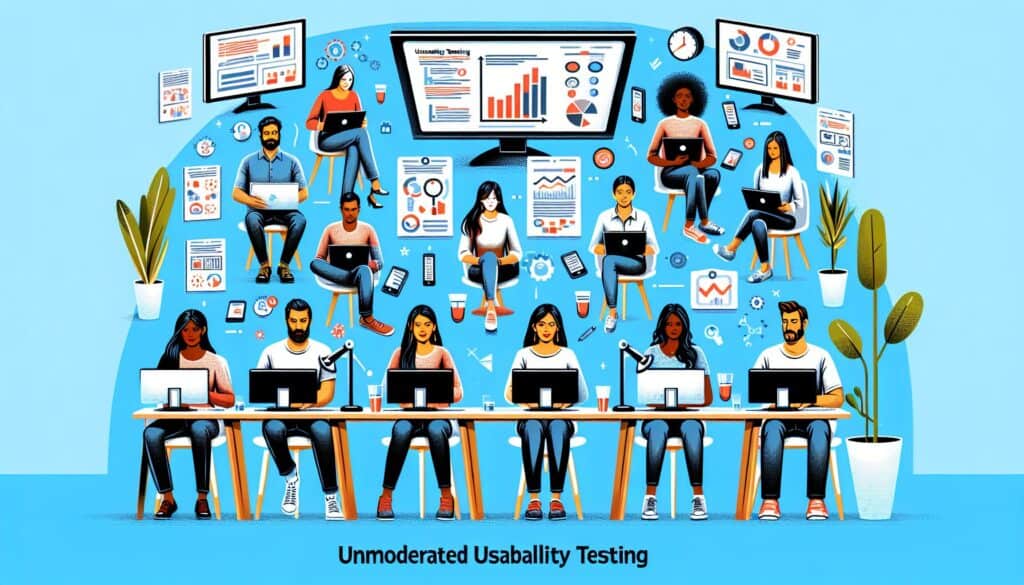A usability evaluation method where participants complete predefined tasks with a product or prototype on their own, without a moderator present, typically using an online testing platform that records their screen, voice (if think-aloud is requested), and clicks.
- Méthodologies : Gestion de projet
Tests d'utilisabilité sans modérateur (souvent à distance)

Tests d'utilisabilité sans modérateur (souvent à distance)
- Évaluation de la conception, Pensée conceptuelle, Interaction homme-machine, Utilisabilité, Tests d'utilisabilité, Expérience utilisateur (UX), Interface utilisateur (UI), Tests auprès des utilisateurs, User-Centered Design
Objectif :
Comment il est utilisé :
- Participants access the test via a link, follow instructions to complete tasks, and their interactions are automatically recorded. They might answer pre- and post-task questions. Data is then reviewed and analyzed by researchers.
Avantages
- More cost-effective and faster to recruit participants and collect data from a larger, more diverse sample; Participants are in their natural environment, potentially leading to more realistic behavior; No moderator bias.
Inconvénients
- No ability to probe or ask follow-up questions in real-time; Participants might misunderstand tasks or encounter technical issues without immediate help; Quality of "think aloud" data can vary greatly; Less control over the testing environment.
Catégories :
- Clients et marketing, Conception de Produits, Qualité
Idéal pour :
- Quickly gathering quantitative and qualitative usability data from a larger number of users, especially for testing specific tasks or validating design iterations when deep probing is not essential.
Unmoderated Usability Testing is particularly applicable in the stages of product development where iterative testing and validation are necessary, such as during prototyping or post-design reviews. Industries utilizing this methodology range from software development and e-commerce to mobile application design and user interface engineering, where rapid feedback cycles are common. Participants often include end-users who can be recruited via platforms like UserTesting or Lookback, allowing for a diverse demographic representation. These tests can be initiated by product managers, UX designers, or researchers who set specific tasks targeting certain features or workflows. As users perform tasks in their natural settings, insights captured reflect authentic interactions with the product, facilitating the identification of usability issues that might not emerge in traditional moderated sessions. This method can also employ various tools for automatic video and screen recording, allowing researchers to analyze user behavior in detail, enhancing the understanding of how users engage with specific elements of the design. Furthermore, the ability to receive both qualitative feedback through post-task questions and quantitative metrics can drive informed decision-making in iterative design processes, helping teams prioritize changes that will significantly enhance user experience.
Principales étapes de cette méthodologie
- Define clear objectives and tasks for the usability test.
- Create a user-friendly test environment accessible via a link.
- Provide participants with straightforward instructions for task completion.
- Automatically record participant interactions during the testing process.
- Include pre-task and post-task questions for additional context.
- Monitor participant behavior indirectly to ensure natural interactions.
- Analyze and interpret the collected data for usability findings.
Conseils de pro
- Utilize task scenarios that reflect real-world contexts to elicit more authentic user behavior and feedback.
- Incorporate qualitative follow-up questions that encourage participants to articulate their thought processes during task completion.
- Implement automated analysis tools for faster data processing, allowing focus on nuanced interpretations of user interactions.
Lire et comparer plusieurs méthodologies, nous recommandons le
> Référentiel méthodologique étendu <
ainsi que plus de 400 autres méthodologies.
Vos commentaires sur cette méthodologie ou des informations supplémentaires sont les bienvenus sur le site web de la Commission européenne. section des commentaires ci-dessous ↓ , ainsi que toute idée ou lien en rapport avec l'ingénierie.
Contexte historique
1986
(si la date est inconnue ou n'est pas pertinente, par exemple "mécanique des fluides", une estimation arrondie de son émergence notable est fournie)

Articles Similaires
Questionnaires sur les troubles musculo-squelettiques
Tests à plusieurs variables (MVT)
Analyse de régression multiple
Systèmes de capture de mouvement
Méthode MoSCoW
Test de la médiane de Mood